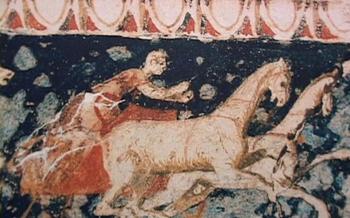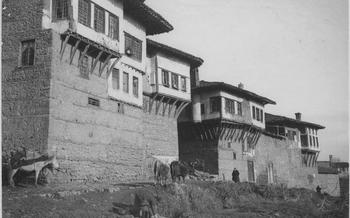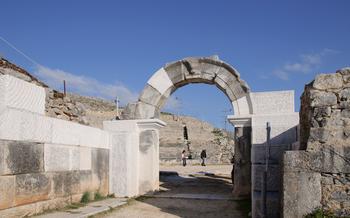
Vergina Sun Landmark
- Vergina Sun Landmark: Unveiling the Symbol of Ancient Kingdom
- Immersive Museum Experience: Delving into History
- Exquisite Gold Jewelry: A Testament to Craftsmanship
- Ancient Theater of Vergina: A Stage for Performances
- Archaeological Museum of Veria: A Treasure Trove of Antiquities
- Royal Tombs of Aigai: A Legacy of Ancient Rulers
- Palatitsia Hill: A Panoramic Vista
- Byzantine Church of Panagia Episkopi: A Sacred Gem
- Traditional Village of Vergina: A Glimpse into the Past
- Archaeological Site of Aigai: Exploring an Ancient City
- Museum of Byzantine Culture: A Journey through History
- Natural Beauty and Outdoor Activities
- Local Cuisine and Culinary Delights
- Insider Tip: Discover the Hidden Gems of Vergina
Vergina Sun Landmark: Unveiling the Symbol of Ancient Kingdom
The Vergina Sun, also known as the Star of Vergina or the Macedonian Sun, is an iconic symbol that holds immense historical significance in Greece. Discovered in 1977 at the ancient city of Aigai, the former capital of the Kingdom of Macedonia, the Vergina Sun has become a symbol of the region's rich history and cultural heritage.
The archaeological excavation of the Vergina Sun was led by Professor Manolis Andronikos, who unearthed the royal tombs of the Macedonian kings, including the tomb of Philip II, father of Alexander the Great. The discovery of the Vergina Sun, depicted on a golden larnax (casket) containing Philip II's remains, brought worldwide attention to the site and sparked a renewed interest in Macedonian history.
The architectural design of the Vergina Sun features a 16-rayed sunburst motif, radiating from a central disc. It is believed to represent the sun god Helios, who was revered in ancient Macedonian religion. The sunburst design is intricately crafted in gold, symbolizing the power and majesty of the Macedonian kingdom.
The Vergina Sun has become a symbol of Greek national pride and cultural identity. It is prominently displayed on the Greek flag and is often used in official emblems and logos. The symbol evokes a sense of historical continuity, linking modern Greece to its ancient roots and the legacy of the Macedonian kingdom.
Immersive Museum Experience: Delving into History
The Vergina Museum is a treasure trove of knowledge and history, providing visitors with an immersive experience that brings ancient Greece to life. Interactive exhibits and displays engage visitors, allowing them to explore the rich history and culture of the region in a hands-on manner. Ancient artifacts and relics, including those discovered in the royal tombs, offer a glimpse into the daily lives, customs, and beliefs of the ancient Macedonians. The museum's storytelling exhibits provide historical context, immersing visitors in the fascinating narratives of the past. Educational programs and workshops further enhance the experience, offering opportunities for deeper learning and engagement with the museum's collection.
Exquisite Gold Jewelry: A Testament to Craftsmanship
The golden treasures excavated from the tomb of Philip II stand as a testament to the unparalleled craftsmanship and artistry of ancient Greeks. Gold held immense significance, symbolizing power, wealth, and divinity. The discovery of intricate jewelry pieces, including a stunning gold wreath, gold diadem, and ornate earrings, revealed the exceptional skills of ancient goldsmiths.
These artifacts, adorned with intricate designs and motifs, showcased the diverse techniques employed by ancient craftsmen. The gold wreath, crafted with delicate filigree work and adorned with leaves and flowers, represents a masterpiece of intricate craftsmanship. The gold diadem, featuring a series of embossed scenes depicting mythological figures, exemplifies the artistic prowess of the ancient Greeks.
The gold jewelry found in the tomb not only served as ornaments but also carried profound symbolic meanings. The wreath, representing victory and achievement, was likely worn by Philip II during his triumphs. The diadem, with its mythological scenes, symbolized the divine authority and connection between the king and the gods.
Beyond their aesthetic and symbolic significance, these golden artifacts provide valuable insights into the social and cultural practices of ancient Greece. The presence of gold jewelry in royal burials highlights the importance of material wealth and the belief in the afterlife. The intricate designs and motifs offer a glimpse into the artistic traditions and beliefs of the ancient Greek civilization.
Ancient Theater of Vergina: A Stage for Performances
Constructed during the Hellenistic period, the Ancient Theater of Vergina stands as a testament to the region's rich cultural heritage. This impressive structure, nestled amidst the picturesque landscape, once hosted a variety of performances that captivated audiences and played a vital role in the social and cultural life of the ancient city.
With its well-preserved seating arrangements, the theater offers a glimpse into the architectural prowess of the ancient Greeks. The tiers of seats, carefully carved into the natural slope, provided spectators with an unobstructed view of the stage. The orchestra, the circular performance space at the center, served as the stage for theatrical productions, musical performances, and other forms of entertainment.
The theater's acoustics are a marvel of ancient engineering, ensuring that the actors' voices carried clearly throughout the auditorium. This allowed for a more immersive and engaging experience for the audience, who could fully appreciate the nuances of the performances.
Beyond its theatrical significance, the Ancient Theater of Vergina also served as a venue for religious ceremonies, political gatherings, and community events. It was a place where people from all walks of life came together to celebrate, mourn, and share in the collective experiences that shaped their society.
Today, the theater stands as a reminder of the vibrant cultural traditions of ancient Greece. It invites visitors to step back in time and imagine the lively performances that once graced its stage, transporting them to a world where art, entertainment, and community spirit intertwined.
Archaeological Museum of Veria: A Treasure Trove of Antiquities
The Archaeological Museum of Veria, a treasure trove of ancient artifacts and relics, invites visitors on a captivating journey through the rich history and culture of Vergina and its surrounding regions. This remarkable museum houses a diverse collection of artifacts spanning various epochs, from the Neolithic Age to the Classical period, providing invaluable insights into the region's past.
Step into the museum's galleries and be greeted by an array of exquisite sculptures, finely crafted pottery, and everyday objects that tell the story of ancient civilizations. Admire the intricate details of Neolithic figurines, marvel at the craftsmanship of Bronze Age tools and weapons, and immerse yourself in the artistry of Classical Greek vases and sculptures.
The museum's collection is not merely a display of artifacts; it is a journey through time, offering a glimpse into the lives, traditions, and beliefs of ancient peoples. Each object holds a unique tale, shedding light on the region's cultural and historical significance.
As you wander through the galleries, you'll discover the remarkable skills and artistry of ancient craftsmen. From the delicate brushstrokes of painted pottery to the intricate carvings on stone sculptures, the museum's collection showcases the exceptional craftsmanship that characterized ancient Greek civilization.
The Archaeological Museum of Veria is more than just a repository of artifacts; it is a place where history comes alive. It invites visitors to delve into the past, to connect with the people who once inhabited this region, and to appreciate the enduring legacy of their culture.
Royal Tombs of Aigai: A Legacy of Ancient Rulers
The Royal Tombs of Aigai, situated in the heart of Vergina, stand as a testament to the grandeur and power of ancient Greek rulers. These imposing structures, initially discovered in the late 19th century, have captivated the world with their exquisite artistry, historical significance, and the wealth of artifacts they contain.
The tombs, dating back to the 4th century BC, served as the final resting places for several prominent figures from the Macedonian dynasty, including King Philip II, father of Alexander the Great. The discovery of these tombs marked a pivotal moment in archaeological history, shedding new light on the lives and customs of the ancient Macedonian royalty.
Inside the tombs, archaeologists unearthed a treasure trove of artifacts, including ornate golden jewelry, weapons, armor, and vessels. These artifacts, many of which are on display at the Vergina Museum, offer a glimpse into the opulence and artistry of the Macedonian court.
The most remarkable discovery within the tombs was the intact burial chamber of King Philip II. The chamber, adorned with intricate frescoes and sculptures, revealed the king's remains alongside an array of precious objects, including a golden wreath and a finely crafted suit of armor.
The Royal Tombs of Aigai have provided invaluable insights into the lives and customs of the ancient Macedonian rulers. They stand as a testament to the power and prestige of the Macedonian dynasty and offer a unique glimpse into the world of ancient Greek royalty.
Palatitsia Hill: A Panoramic Vista
Overlooking the town of Vergina, Palatitsia Hill beckons with its captivating allure. A place of historical significance and breathtaking beauty, the hill offers a panoramic vista that will remain etched in your memory.
Ascend the gentle slopes, and you will be greeted by a breathtaking view of the surrounding landscape. The town of Vergina, with its terracotta rooftops and winding streets, nestles amidst a verdant valley. Mountains rise majestically in the distance, their peaks capped with snow. The panorama is a testament to the harmonious coexistence of nature and history.
The hilltop is adorned with ancient ruins, remnants of a glorious past. Explore the foundations of an ancient fortress, once a strategic stronghold guarding the region. Discover the remnants of a temple dedicated to the goddess Artemis, where echoes of ancient rituals still linger.
Palatitsia Hill is not just a historical site; it is also a haven for nature lovers. Wander through the verdant groves of olive trees, inhaling the heady scent of their silvery leaves. Listen to the gentle rustle of the wind as it caresses the branches, creating a symphony of nature.
For those seeking outdoor adventures, Palatitsia Hill offers a multitude of opportunities. Embark on a leisurely hike along the well-marked trails, immersing yourself in the beauty of the surrounding flora and fauna. Mountain bikers will find challenging trails that wind through the rugged terrain, providing an adrenaline-pumping experience.
As the sun begins to set, the hilltop transforms into a magical realm. The sky bursts into a canvas of vibrant hues, casting a golden glow upon the ancient ruins. The air is filled with a sense of tranquility, inviting you to savor the moment and reflect upon the rich history that unfolds before you.
Palatitsia Hill is a true gem that offers a harmonious blend of history, nature, and breathtaking vistas. Whether you seek adventure, tranquility, or a glimpse into the past, this enchanting hilltop promises an unforgettable experience.
Byzantine Church of Panagia Episkopi: A Sacred Gem
The Byzantine Church of Panagia Episkopi, situated in the heart of Vergina, stands as a testament to the region's rich religious history and architectural splendor. Built in the 11th century, this stunning edifice showcases intricate Byzantine artistry and craftsmanship. Its remarkable frescoes, adorned with vivid colors and expressive figures, depict scenes from the Bible and the life of Christ, offering a glimpse into the spiritual beliefs and artistic traditions of the Byzantine era.
Beyond its artistic significance, the church holds immense historical importance. It served as a religious center and gathering place for the local community throughout the Byzantine period and beyond. Its well-preserved condition and ongoing use as a place of worship make it a living testament to the enduring legacy of Byzantine Christianity in Vergina.
Stepping inside the church, visitors are greeted by an awe-inspiring atmosphere of tranquility and reverence. The domed ceiling, supported by graceful arches, creates a sense of grandeur and spaciousness. The walls are adorned with a series of stunning frescoes, depicting scenes from the life of Jesus, the Virgin Mary, and various saints. The vibrant colors and expressive figures bring the stories to life, offering a glimpse into the beliefs and values of the Byzantine people.
The church's interior also features a beautifully carved wooden iconostasis, separating the sanctuary from the nave. This intricate screen, adorned with icons of Christ, the Virgin Mary, and various saints, serves as a focal point of the church's interior and adds to its overall aesthetic appeal.
The Byzantine Church of Panagia Episkopi is not only a place of worship but also a significant cultural and historical landmark. Its stunning architecture, exquisite frescoes, and rich history make it a must-visit attraction for anyone interested in Byzantine art, history, and religion.
Traditional Village of Vergina: A Glimpse into the Past
Amidst the archaeological wonders of Vergina lies a charming traditional village that invites visitors to experience the essence of Greek heritage and hospitality. Stroll along the cobbled streets lined with whitewashed houses adorned with colorful bougainvillea. Engage with the locals who warmly welcome visitors and share stories of their ancestors.
Discover historical landmarks such as the 19th-century stone bridge, a testament to the village's rich past. Admire the traditional architecture, with its distinctive Macedonian-style houses featuring overhanging upper floors and intricate carvings.
Indulge in local cuisine at traditional tavernas serving mouthwatering dishes prepared with fresh, locally sourced ingredients. Savor the flavors of slow-cooked stews, grilled meats, and homemade pies. Pair your meal with local wine or ouzo, and immerse yourself in the convivial atmosphere as locals and visitors mingle.
Participate in festivals and events that celebrate Vergina's cultural heritage. Witness traditional dances, listen to live music, and savor local delicacies at the annual Vergina Festival. Join the locals in celebrating religious holidays with processions, feasts, and lively gatherings.
For a truly immersive experience, consider staying in one of the traditional guesthouses, where you can enjoy warm hospitality and a taste of authentic village life. Vergina's traditional village is a treasure trove of cultural experiences, offering a glimpse into the past while embracing the present.
Archaeological Site of Aigai: Exploring an Ancient City
Amidst the rolling hills of Imathia, the archaeological site of Aigai unveils the remnants of an ancient city that once served as the capital of the powerful kingdom of Macedonia. Wander through the ruins of Aigai and immerse yourself in the grandeur of its past. Explore the remnants of city walls and fortifications that once protected the city from invaders. Discover the foundations of public buildings, temples, and residential areas, each revealing glimpses into the daily lives of Aigai's inhabitants. Archaeological excavations have unearthed a wealth of artifacts, including pottery, coins, and sculptures, providing valuable insights into the city's history and culture. As you explore Aigai, let your imagination transport you back in time to witness the bustling streets, the vibrant markets, and the grandeur of a city that played a pivotal role in shaping the course of ancient Greek history.
Museum of Byzantine Culture: A Journey through History
Immerse yourself in the rich history and artistry of the Byzantine Empire at the Museum of Byzantine Culture. This captivating museum houses an extensive collection of Byzantine art and artifacts, shedding light on the empire's cultural and religious heritage. Admire exquisite religious icons, marvel at intricate manuscripts, and discover the stories behind the empire's rise and fall. Through interactive exhibits and educational programs, the Museum of Byzantine Culture offers a comprehensive journey through Byzantine history, providing insights into the empire's artistic achievements, social customs, and religious beliefs.
Natural Beauty and Outdoor Activities
Vergina's natural beauty provides a serene escape from the historical sites. Embrace the great outdoors with hiking trails that wind through picturesque landscapes, inviting you to explore the surrounding mountains and countryside. Discover hidden waterfalls, lush forests, and panoramic views that will take your breath away.
For water enthusiasts, Vergina offers a variety of recreational activities. Take a refreshing dip in the crystal-clear waters of the nearby lakes, perfect for swimming, fishing, and boating. Experience the thrill of kayaking or canoeing along the tranquil rivers, immersing yourself in the tranquility of nature.
Nature lovers will delight in exploring the natural parks and wildlife sanctuaries that showcase the region's rich biodiversity. Encounter a diverse array of flora and fauna, from vibrant wildflowers to majestic birds soaring overhead. Capture the beauty of nature through photography or simply relax and soak in the serenity of the surroundings.
Local Cuisine and Culinary Delights
Vergina and the surrounding region offer a diverse culinary landscape that reflects the rich traditions and fresh produce of the area. Indulge in mouthwatering dishes prepared with locally sourced ingredients, embodying the essence of Greek cuisine. From savory grilled meats and succulent seafood to aromatic stews and traditional pastries, the flavors of Vergina will tantalize your taste buds.
Don't miss the opportunity to savor the region's signature dishes, such as the hearty lamb kleftiko, slow-cooked in a clay oven with herbs and vegetables, or the delectable pastitsio, a baked pasta dish layered with minced meat, béchamel sauce, and cheese. For seafood lovers, the grilled octopus and fresh fish caught daily from the Aegean Sea are must-try delicacies.
Immerse yourself in the local culinary culture by visiting traditional tavernas and restaurants in Vergina. Engage with the friendly locals and learn about their favorite dishes and recipes. Cooking classes and culinary workshops are also available, offering a hands-on experience to create your own Greek culinary masterpieces.
Explore the vibrant local markets, where you can find an array of fresh fruits, vegetables, herbs, and spices, as well as traditional cheeses, olives, and honey. These markets provide a glimpse into the daily life of the locals and offer the chance to interact with the warm and welcoming community.
Don't forget to satisfy your sweet tooth with the delectable pastries and desserts of Vergina. Indulge in flaky baklava, crispy loukoumades, or the traditional galaktoboureko, a creamy custard pie topped with phyllo dough.
Insider Tip: For a truly unique dining experience, venture off the beaten path and seek out hidden gems known only to the locals. Ask for recommendations from your hotel concierge or engage in conversations with friendly locals to uncover secret spots that offer authentic flavors and a genuine taste of Vergina's culinary treasures.
Insider Tip: Discover the Hidden Gems of Vergina
Beyond the well-known landmarks, Vergina conceals a wealth of hidden gems waiting to be discovered by curious travelers. Venture off the beaten path to uncover these lesser-known treasures. Explore the picturesque village of Palatitsia, nestled amidst olive groves and offering panoramic views of the surrounding countryside. Discover the Byzantine Church of Agios Georgios, adorned with exquisite frescoes and a serene ambiance. Stroll through the traditional neighborhood of Kato Vergina, with its charming cobblestone streets and authentic architecture. Immerse yourself in local culture by visiting the Vergina Folklore Museum, showcasing traditional costumes, handicrafts, and everyday objects that tell the story of the region's rich heritage. These hidden gems offer a unique perspective on Vergina's past and present, providing a deeper connection to its essence.






